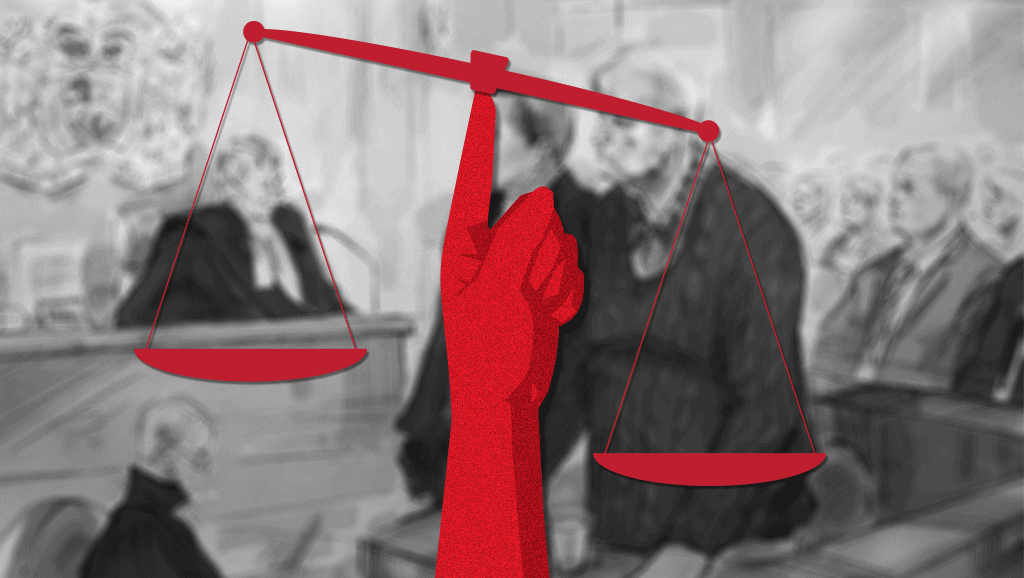Amid a day of horrors heard in the courtroom, it produces the most terrible gasp: how totally and utterly a serial killer was delivered into the hands of the Toronto police after strangling a man who miraculously escaped only for the police to then, unbelievably, let that killer go, setting him back upon a community he had ravaged and would ravage still.
At least three more men died after that.
After the man’s escape, the period between Bruce McArthur’s murders escalates, and he keeps dehumanizing photographs of this attempted victim alongside the others in the computer folder he meticulously maintains.
McArthur’s public expressions of fondness for the Toronto police then increase, too. In July 2016, his Facebook page (since deleted by the police force) makes broad statements of support for police presence at Pride functions and parades. McArthur takes smiling photos of cops marching and posts them alongside colourful memes: “MY PRIDE INCLUDES POLICE.”
When McArthur is finally arrested again in 2018, Mark Saunders, the chief of police who previously insisted there was no evidence of a serial killer, claims in a stunning about-face that no one had come forward: “We knew that people were missing and we knew we didn’t have the right answers. But nobody was coming to us with anything.”
Among the enraged communities who hear Saunders speak this manifest lie, somewhere is the survivor who had given his testimony about McArthur to police through his injured windpipe.

The picture that emerges in court of McArthur is of a man neither intelligent nor careful.
As the Crown submits its exhibits, we learn that McArthur had kept massive amounts of evidence in his residence, in his car, at his places of work. He was passingly familiar with or directly linkable to many of the victims, retained the murder weapon to re-use in crime after crime, and kept notebooks, missing posters, trophies and digital images of his victims that he clumsily deleted, only later to have them recovered by police. When a fur coat was eventually found in his vehicle, it had traces of blood from multiple victims.
This makes the victim impact statements being read in court all the more painful, as communities that begged police to investigate the murders proliferating in the Village have now discovered just how quickly he might have been apprehended — and how perniciously he had insinuated himself through their lives.
One witness reads a testimony, reflecting on the devastation McArthur’s actions has made of his days: depression, drinking, job and relationship issues, weight gain — a story like so many that crash against us, wave after wave. He recalls the day his friend’s killer was found and McArthur’s image began appearing in media reports: “I felt incredibly guilty for not being able to recognize the offender for what he was. I prided myself on being a good judge of character.”
His eyes blaze with anger and tears: “But I didn’t see the wolf in the fold.”

Outside the courthouse, a woman in a reflective vest stands beside an enormously crudely inflated Santa Claus. Beside her is a sign: “INVESTIGATE & REGULATE: Bruce McArthur was a mall Santa Claus with a conviction of a violent crime all along he was a serial killer.” She is, I overhear as she yells into a reporter’s microphone, furious that he was in proximity to children, and is demanding background checks for people who work with them.
The eight gay men whose deaths are a matter of record, and the many more cold cases reactivated in the Village dating as early as the ’70s in the wake of McArthur’s actions, seem to trouble her considerably less.
Back inside the courtroom, Santa placard in hand, she hisses that I am, she has decided, “in her seat.”

Sitting in court, Bruce McArthur’s eyes do not blaze.
We have by now become inured to the jolly, plump image the media is fond of circulating of him. But instead of a Santa Claus, McArthur is now a shrunken, mottled thing. His skin is grey and his back is stooped. When his hands are uncuffed they tremble; otherwise he is completely still.
It is an urgent, necessary question of law whether McArthur would receive concurrent or consecutive life sentences; his 25 years before parole at least spares the Village the drawn-out appeal of a potential Charter Rights violation, as now appears to be the case in the parallel Alexandre Bissonnette sentencing. But it is a baldly legible fact that McArthur will not outlive even the earliest opportunity for parole. He looks, indeed, like a dead thing already — like a fallen, guttered crabapple, its insides pulling away from its peel.
I have been troubled by nightmares of this man since before I had a name or face to give him, and now seeing him in court, he does not even seem to wear that face convincingly. I remember Dante, in Hell, stumbling upon a man he knows is still alive up above, and learning some crimes are so terrible that the soul is lost and damned immediately, leaving the body to walk the earth, animated for the sake of appearances by a demon pilot instead.
It is bad theology, and worse ethics, but it has never felt so apt. I find, to my surprise, that I cannot hate him or pity him. It feels like there is barely anything there to hate or pity at all.

Deanna Dudley of the Metropolitan Community Church gives her testimony on behalf of her congregants. I remember, during the vigil held for McArthur’s victims last February, her gesturing to the spot where decades prior, one of the first legal gay marriages performed in modernity was enacted. Now, she tells us of the hard work of volunteers turning the exhumed site of McArthur’s mass grave into something other than a body dumping ground.
There in spring, she promises us, daffodils will grow.
This indignity of depersonalization — bodies sown, helter-skelter, in a field — is a realization of McArthur’s habit of mind. We learn in court that while McArthur sometimes knew his victims quite intimately, some were aliased to him — all in the end useful props who fit a profile, and whom he seemed to need to re-instantiate a rigorously choreographed tableau. In his file folder, he sometimes labelled them only “Turkish Guy” or “#4.”
In death, they are subjected to a similar depersonalization, and I am therefore most horrified by moments when my mind stammers and struggles to keep these victims distinct. Which was the refugee? Which the vegan? Who left a daughter, and who a wife? Even now, even after months, the victims bleed together, and that bleeding is another way he has wounded us.
As victim impact statements are read one after the other, one-by-one, these men come alive for us, and we see how traumatizing a loss has been suffered. The gentle decency of Selim Esen; Andrew Kinsman, tending a rooftop garden; Skanda, “unbeatable at Scrabble,” and his doting and now aged mother, who had not been told what became of her son. One-by-one, the men become people again and are lost again — a theatre of cruelty meant to reenact just how much has been taken: Skandaraj Navaratnam. Abdulbasir Faizi. Majeed Kayhan. Kirushna Kumar Kanagaratnam. Soroush Mahmudi. Dean Lisowick. Selim Esen. Andrew Kinsman.
And to the litany let us add the man who escaped, and the man who was saved, and the many whose names we do not know — who were perhaps McArthur’s victims, or perhaps were killed by other monsters.
Reporters ask me how I think the Village will heal. I am fascinated by which communities are asked to “heal.” I know that McArthur will die in prison. But he didn’t kill Tess Richey. Nor did he leave Alloura Wells in a morgue. Nor did he handcuff gay closeted men in parks by the scores, nor take a sledgehammer to the bathhouses.
When Doug Ford, the Ontario premier elected in many ways as the heterosexual response to these murders, is asked what will happen next, he replies that he is sick of people “dumping on” the police. He meanwhile meets behind closed doors with anti-trans activists, and continues to roll back sex education to exclude mention of LGBTQ2 people. The space and system that let McArthur thrive for so long still yawns open, covering the past and stretching to darken the future.
That night, after listening to these stories and facing the man that tormented us for so long, I find that instead of the old nightmares of the unknown shape in the dark, I dream of a man with too many faces, and no face at all.
I wake, and am waiting for daffodils.


 Why you can trust Xtra
Why you can trust Xtra


